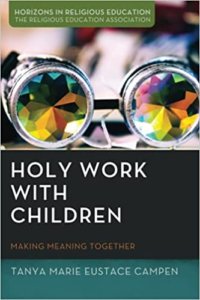Tanya Campen offers six tools to help children process their experiences and discoveries about God. Through story, liturgy and ritual, relational awareness, memory markers, wonder, and work, children experience and respond to God’s presence and love.
Recognizing that children learn about God in varying contexts and traditions, and acknowledging all children learn and process at different paces and in different ways, here are six tools that are helpful as they process their experiences and discoveries:
1. Story
How we tell stories is important. Stories can be presented in numerous ways including a simple telling of the story, reading from a book, or acting out the story, too. Remembering that all children learn differently, we should always provide various ways for children to engage in different ways of utilizing different learning styles and multiple intelligences learning theory. Children enjoy being connected to, invited into, and incorporated in the unfolding of the story. They yearn for a space where they can actively participate and reflect on the information presented. When the story is told in an engaging way, children stop and pay attention. It is our work to invite them into the story, to wonder with them, and to encourage them as they engage with the people and events that take place.
2. Liturgy and ritual
Sharing with the children the schedule or flow for the day invites them in as full participants, helps them know what to expect, and encourages them to discover their favorite part of our time together. It is important that we are intentional in structuring our time with children, creating a liturgical flow that teaches, models, and invites children to practice the actions of our faith communities. We need to make sure that there is a pattern and rhythm created so that all persons participating are able to feel the flow of the time allotted. Repeating liturgy and words weekly helps children to learn the words and gestures for themselves. When we follow a consistent flow or liturgy, children will learn what to expect and will begin to participate more fully. When we do this work well children begin to experience each part of the liturgy as anchors, grounding them in the work and inviting them in as full participants.
3. Relational awareness
Children have a relational awareness that helps them make meaning out of their experiences.
Self — Children express a sense of their awareness of themselves as they talk about their discoveries using “I” language, reflecting on their own experiences. It is essential that we find ways to create space and time for children to do the deep thinking necessary for this work and then listen attentively as they find words to express their thoughts.
God — The more we tell stories and create space for children to share theirs, the greater the possibility that children will begin to hear and see God at work in their lives.
Others — Children’s relational awareness of others highlights the importance of community in their meaning-making process. As children engage in this process, their relational awareness provides a tool that equips them to recognize how the words in liturgy and story connect to them as individuals, as God’s beloved creation, and as part of the faith community.
4. Memory markers: locations, objects, and symbols
Memory markers are children’s ways of remembering what they have experienced and learned as they do the holy work of making meaning. Locations, objects, and symbols represent memory markers or place holders, helping the children remember the specific events of their stories. Children use these tools to claim their experiences as they make meaning that will become an essential part of their faith narrative on which they will continue to build and rely. The meaning made in these memories as captured and claimed via locations, objects, and symbols become the building blocks for children as they continue to grow in their awareness of God and deepen their faith.
5. Wonder
Wondering offers children an opportunity to make meaning as they enter and respond to the mystery of God. Through wondering children take time to process internally or externally what they are experiencing and begin to sort through that data as they initiate the meaning-making process that deepens their understanding and strengthens their faith.
Wondering begins with the understanding that there may be more than one answer to a given question. The children’s active wondering gives them a way to imagine and wonder out loud and in community. It gives them an opportunity to learn and to teach. To share observations and to make meaning with others.
6. Work
Through play, a child does the important work of recognizing, claiming, and responding to God’s presence in their lives. Our job as ministry leaders is to create space for both independent and communal unstructured play. It is important to give children permission to choose their work based on their individual interests and skills. In individual class settings we might invite children to read (the Bible or other stories about God), to be creative with art supplies, to work with a labyrinth, to act out the story with props, or to journal. We can invite them to go outside as they engage in their time of work, or we might create space for play in our classrooms. In the church, we can invite and encourage them to participate in the faith community by helping lead worship as acolytes, greeters, ushers, readers, and even preachers! They can be on ministry teams, sharing their ideas as churches discern how to lead one another in stewardship, outreach, or other ministries.
They can participate in age-appropriate ministry opportunities, too, such as helping to serve a meal to the poor, making artwork to send to shut-ins, or collecting supplies for people in need. The important step is that churches pay attention to the young people in their communities and give them real and valuable opportunities to play and to work using the gifts God gives them.
Children, just like adults, are called and equipped for the holy work of making a difference in their communities and in the world. As they move through their meaning-making process, they engage, recognize, claim, and respond to God’s presence and love. As ministry leaders it is our work to create space that invites children to play and to do holy work as they process and discern ways God is calling them to respond to all they are learning and experiencing.
 This article is adapted from Holy Work with Children: Making Meaning Together (Pickwick Publications, 2021) by Tanya Campen. Used with permission from Wipf and Stock Publishers, www.wipfandstock.com. This book is available at Wipf and Stock, Cokesbury, and Amazon.
This article is adapted from Holy Work with Children: Making Meaning Together (Pickwick Publications, 2021) by Tanya Campen. Used with permission from Wipf and Stock Publishers, www.wipfandstock.com. This book is available at Wipf and Stock, Cokesbury, and Amazon.
Related Resources
- Engaging Children Through Active Wondering by Tanya Campen
- Creating a Safe Space for Holy Work with Children by Tanya Campen
- The Holy Work of Hybrid and Virtual Christian Education featuring Tanya Campen — Leading Ideas Talks podcast episode | Podcast video | In-depth interview
- 50 Ways to Strengthen Ministry With Children, a free Lewis Center resource
Image by Freepik







